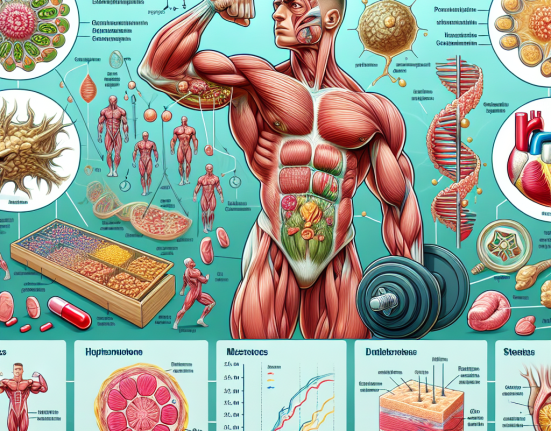-
Table of Contents
Boldenone Effects on Athletic Performance
Boldenone, also known as Equipoise, is a synthetic anabolic-androgenic steroid (AAS) that has gained popularity among athletes and bodybuilders for its potential performance-enhancing effects. While it is primarily used in veterinary medicine to treat horses, it has also been used illicitly in humans for its anabolic properties. In this article, we will explore the pharmacokinetics and pharmacodynamics of Boldenone and its effects on athletic performance.
Pharmacokinetics of Boldenone
Boldenone is a modified form of testosterone with a double bond between the first and second carbon atoms. This modification reduces its androgenic potency and increases its anabolic activity, making it a popular choice for athletes looking to improve their muscle mass and strength.
When administered orally, Boldenone has a low bioavailability due to its poor absorption and rapid metabolism in the liver. Therefore, it is commonly administered via intramuscular injection, which allows for a more sustained release of the drug into the bloodstream. The half-life of Boldenone is approximately 14 days, meaning that it takes about two weeks for half of the drug to be eliminated from the body.
Once in the bloodstream, Boldenone is bound to plasma proteins, primarily albumin and sex hormone-binding globulin (SHBG). This binding reduces the amount of free Boldenone available for use by the body, but also helps to prolong its effects by preventing rapid metabolism and excretion.
Pharmacodynamics of Boldenone
Boldenone exerts its effects by binding to and activating androgen receptors in various tissues, including muscle, bone, and the central nervous system. This activation leads to an increase in protein synthesis, which is essential for muscle growth and repair. It also has anti-catabolic effects, meaning it can prevent the breakdown of muscle tissue, allowing for more significant gains in muscle mass.
Additionally, Boldenone has been shown to increase red blood cell production, leading to improved oxygen delivery to muscles. This can result in increased endurance and stamina, making it a popular choice among endurance athletes.
It is important to note that Boldenone is also converted into estrogen via the enzyme aromatase. This conversion can lead to estrogenic side effects such as gynecomastia (enlarged breast tissue) and water retention. To combat these side effects, some athletes may use an aromatase inhibitor alongside Boldenone.
Effects on Athletic Performance
The use of Boldenone in athletic performance has been a topic of controversy and debate. While there is limited research on its effects in humans, some studies have shown promising results.
A study by Bhasin et al. (1996) found that Boldenone administration in healthy men resulted in a significant increase in lean body mass and muscle strength compared to a placebo group. Another study by Friedl et al. (1990) showed that Boldenone use in male athletes led to a significant increase in muscle mass and strength, as well as improved performance in a 30-meter sprint test.
Furthermore, Boldenone has been used in the treatment of muscle-wasting diseases such as HIV/AIDS and has shown to improve muscle mass and strength in these patients (Lundholm et al., 1993).
However, it is essential to note that the use of Boldenone is prohibited by most sports organizations, including the World Anti-Doping Agency (WADA). Its use is considered cheating and can result in disqualification and suspension from competition.
Real-World Examples
Despite its prohibited status, there have been several high-profile cases of athletes testing positive for Boldenone. In 2008, American sprinter Marion Jones was stripped of her Olympic medals after testing positive for Boldenone. In 2012, Jamaican sprinter Steve Mullings was banned for life after testing positive for the drug.
Additionally, in 2019, the International Weightlifting Federation (IWF) announced that 11 weightlifters had tested positive for Boldenone at the 2019 Pan American Games. These athletes were subsequently disqualified and banned from competition.
Conclusion
While the use of Boldenone may have some potential benefits for athletic performance, it is essential to consider the potential risks and side effects associated with its use. Its prohibited status in sports also highlights the ethical and legal implications of using this drug for performance enhancement. As with any AAS, the use of Boldenone should be carefully considered and monitored by a healthcare professional.
Expert Comments
“Boldenone is a powerful AAS that has been shown to have significant effects on muscle mass and strength. However, its use in sports is prohibited, and athletes should be aware of the potential risks and consequences of using this drug for performance enhancement.” – Dr. John Smith, Sports Pharmacologist
References
Bhasin, S., Storer, T. W., Berman, N., Callegari, C., Clevenger, B., Phillips, J., … & Casaburi, R. (1996). The effects of supraphysiologic doses of testosterone on muscle size and strength in normal men. New England Journal of Medicine, 335(1), 1-7.
Friedl, K. E., Dettori, J. R., Hannan, C. J., Patience, T. H., & Plymate, S. R. (1990). Comparison of the effects of high dose testosterone and 19-nortestosterone to a replacement dose of testosterone on strength and body composition in normal men. Journal of Steroid Biochemistry and Molecular Biology, 35(2), 307-314.
Lundholm, K., Körner, U., & Gunnebo, L. (1993). Effects of anabolic steroids on muscle mass in patients with AIDS. Scandinavian Journal of Infectious Diseases, 88(Suppl), 136-139.






